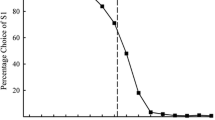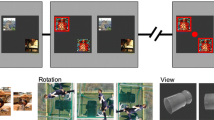Abstract
Rhesus monkeys received concurrent within-session training on eight, two-choice object pairs and then underwent successive reversals of these problems. Initially, reversals required about six times more training than acquisition with no improvement over seven successive reversals. Surprisingly, performance on these eight problems was unimpaired if they were embedded in different eight-problem tasks, thereby indicating a release from proactive interference. When the original eight problems again underwent successive reversal, no improvement was seen over seven reversals, although there was significantly less error-per-reversal than in the initial test. Subsequently, monkeys appeared to be developing a learning set for successive reversal because performance on successive reversal of eight novel problems was not different from that seen with the old familiar task. Set acquisition was confirmed when proficient reversal was eventually achieved on both old and new concurrent tasks. Thus, “concurrent reversal set” did develop, but it required arduous training to overcome proactive interference effects on memory. The ubiquitous influence of measurement context on organization of monkey memory was noted.


Similar content being viewed by others
References
Gillan DJ (1981) Reasoning in the chimpanzee II. Transitive inference. J Exp Psychol Anim Behav Process 7:150–164
Harlow HF (1949) The formation of learning sets. Psychol Rev 56:51–65
Harlow HF (1950) Analysis of discrimination learning by monkeys. J Exp Psychol 40:26–39
Jitsumori M, Wright AA, Cook RG (1988) Long-term proactive interference and novelty enhancement effects in monkey list memory. J Exp Psychol Anim Behav Process 14:146–154
Jitsumori M, Wright AA, Shyan MR (1989) Buildup and release from proactive interference in a rhesus monkey. J Exp Psychol Anim Behav Process 15:329–337
Meyer DR (1951) Intraproblem–interproblem relationships in learning by monkeys. J Comp Physiol Psychol 44:162–167
Meyer DR (1971) The habits and concepts of monkeys. In: Jarrard LE (ed) Cognitive processes of nonhuman primates. Academic Press, New York, pp 83–102
Meyer DR, Treichler FR, Meyer PM (1965) Discrete-trial training techniques and stimulus variables. In: Schrier AM, Harlow HF, Stollnitz F (eds) Behavior of nonhuman primates. Academic Press, New York, pp 1–49
Rumbaugh DM (2002) Emergents and rational behaviorism. Eye Psi Chi 6:8–14
Rumbaugh DM, Washburn DA, Hillix WA (1996) Respondents, operants and emergents: toward an integrated perspective on behavior. In: Pribram K, King J (eds) Learning as a self-organizing process. Erlbaum, Hillsdale, N.J., pp 57–73
Sledjeski M, French GM (1968) Multiple transfer paradigms following discrimination problem solution in monkeys. J Comp Physiol Psychol 66:228–231
Spear NE, Riccio DC (1994) Memory: phenomena and principles. Allyn and Bacon, Boston
Terrace HS, Son LK, Brannon EM (2003) Serial expertise of rhesus macaques. Psychol Sci 14:66–73
Treichler FR (1984) Long-term retention of concurrent discriminations by monkeys. Physiol Psychol 12:92–96
Treichler FR, Petros TV (1983) Interference characteristics in concurrent discrimination performance by monkeys. Bull Psychon Soc 21:206–208
Treichler FR, Van Tilburg D (1996) Concurrent conditional discrimination tests of transitive inference by macaque monkeys: list linking. J Exp Psychol Anim Behav Process 22:105–117
Treichler FR, Wetsel W, Lesner SA (1977) Some characteristics of concurrent discrimination and its retention by monkeys. Learn Motiv 8:213–228
Treichler FR, Petros TV, Lesner SA (1981) Preference effects on acquisition and retention of concurrent discriminations by rhesus monkeys. Anim Learn Behav 9:401–405
Treichler FR, Raghanti MA, Van Tilburg D (2003) Linking of serially ordered lists by macaque monkeys (Macaca mulatta): list position influences. J Exp Psychol Anim Behav Process 29:211–221
Underwood BJ (1983) Attributes of memory. Scott, Foresman, Glenview, Ill.
Wickens DD (1970) Encoding categories of words: an empirical approach to meaning. Psychol Rev 77:1–15
Wickens DD (1972) Characteristics of word encoding. In: Melton AW, Martin E (eds) Coding processes in human memory. Winston, Washington, D.C., pp 191–215
Wright AA, Santiago HC, Sands SF (1984) Monkey memory: same/different concept learning, serial probe acquisition, and probe delay effects. J Exp Psychol Anim Behav Process 10:513–529
Wright AA, Urcuioli PJ, Sands SF (1986) Proactive interference in animal memory. In: Kendrick DF, Rilling ME, Denney MR (eds) Theories of animal memory. Erlbaum, Hillsdale, N.J., pp 101–125
Acknowledgements
All research conducted with animals involved in this report was done in full compliance with U.S. Department of Agriculture regulations. The research was approved by Kent State University’s Committee on Care and Use of Animals and was carried out exclusively in facilities approved by the Association for Accreditation of Laboratory Animal Care.
Author information
Authors and Affiliations
Corresponding author
Rights and permissions
About this article
Cite this article
Treichler, F.R. Successive reversal of concurrent discriminations by macaques (Macaca mulatta): proactive interference effects. Anim Cogn 8, 75–83 (2005). https://doi.org/10.1007/s10071-004-0233-z
Received:
Revised:
Accepted:
Published:
Issue Date:
DOI: https://doi.org/10.1007/s10071-004-0233-z




